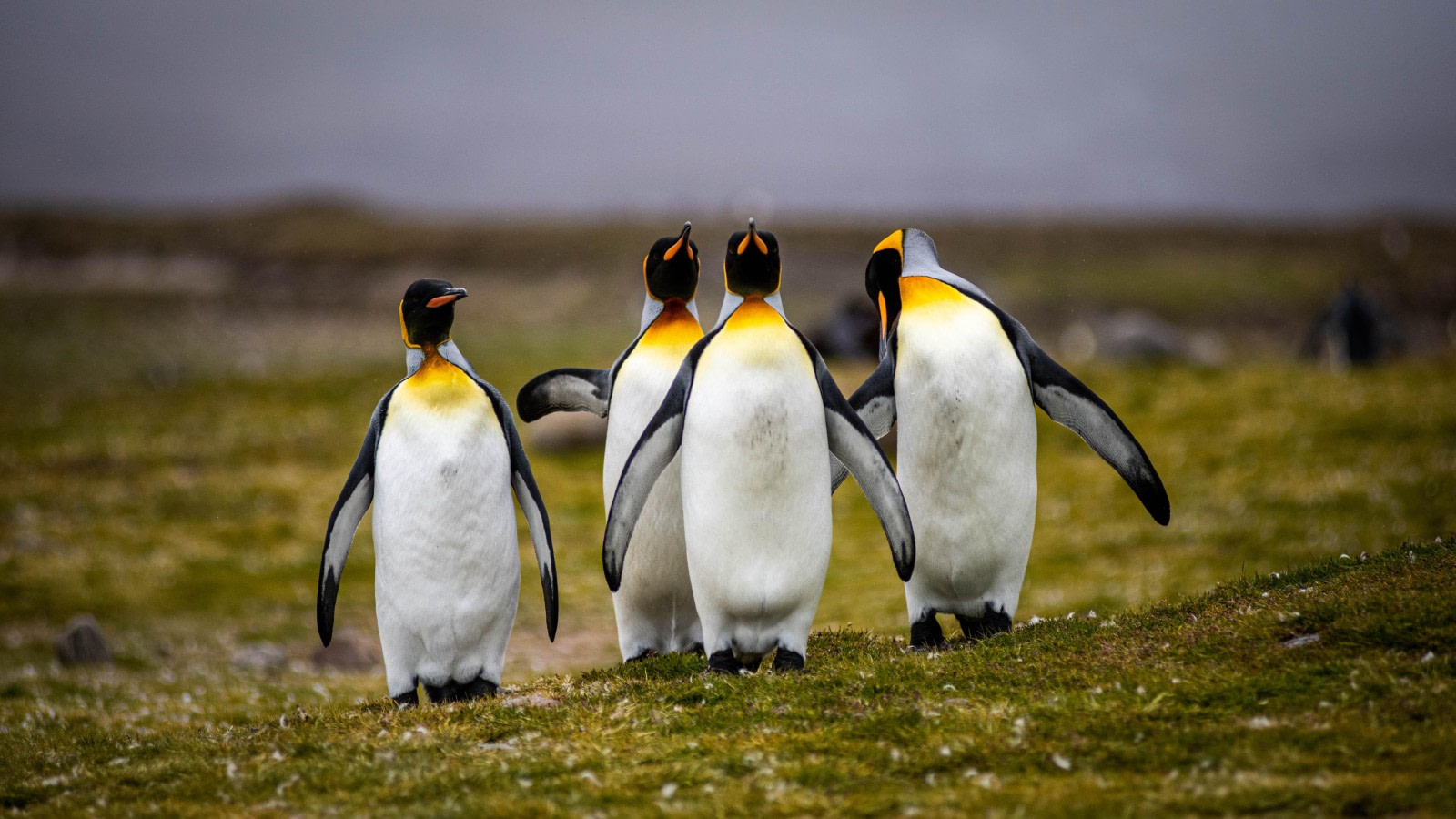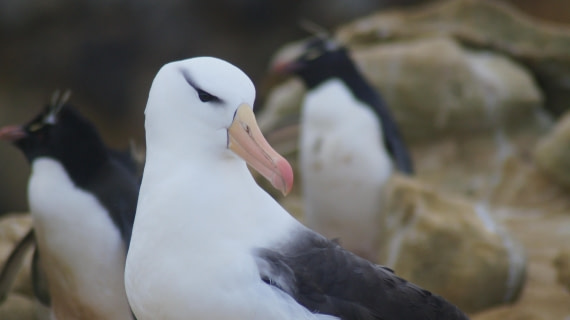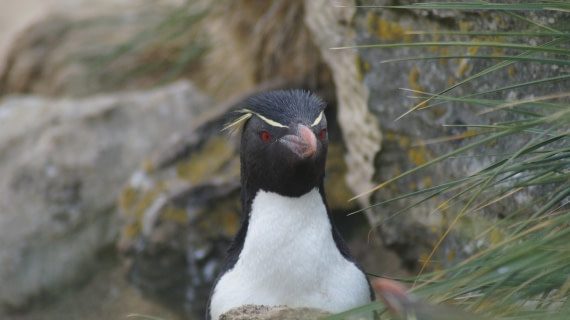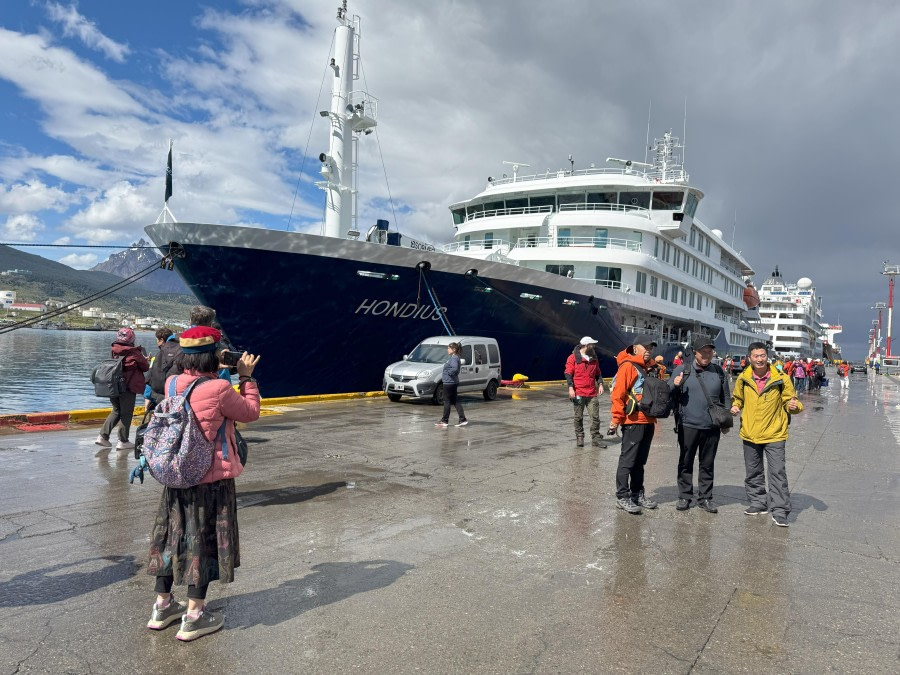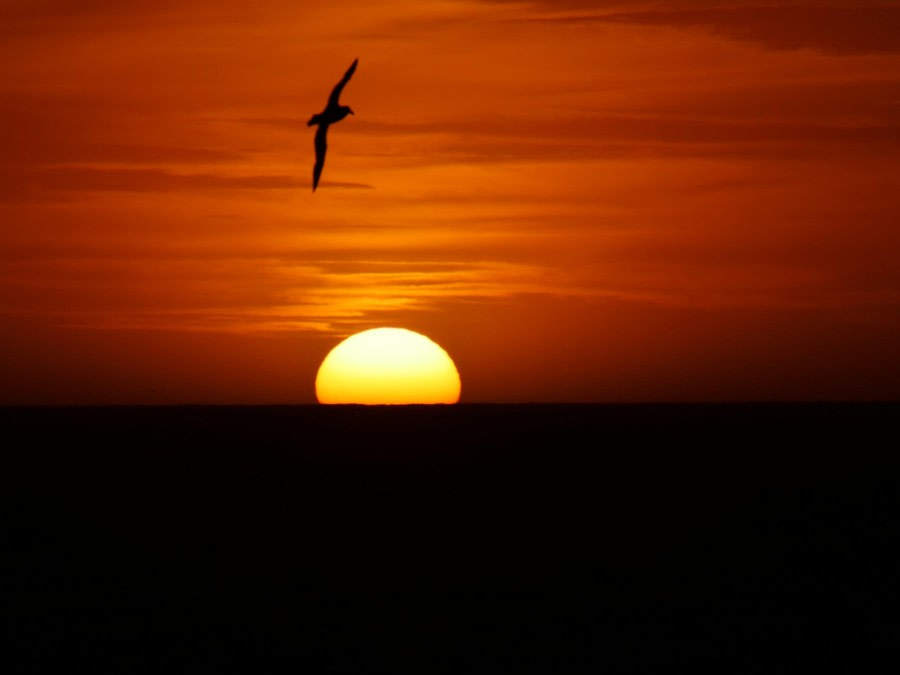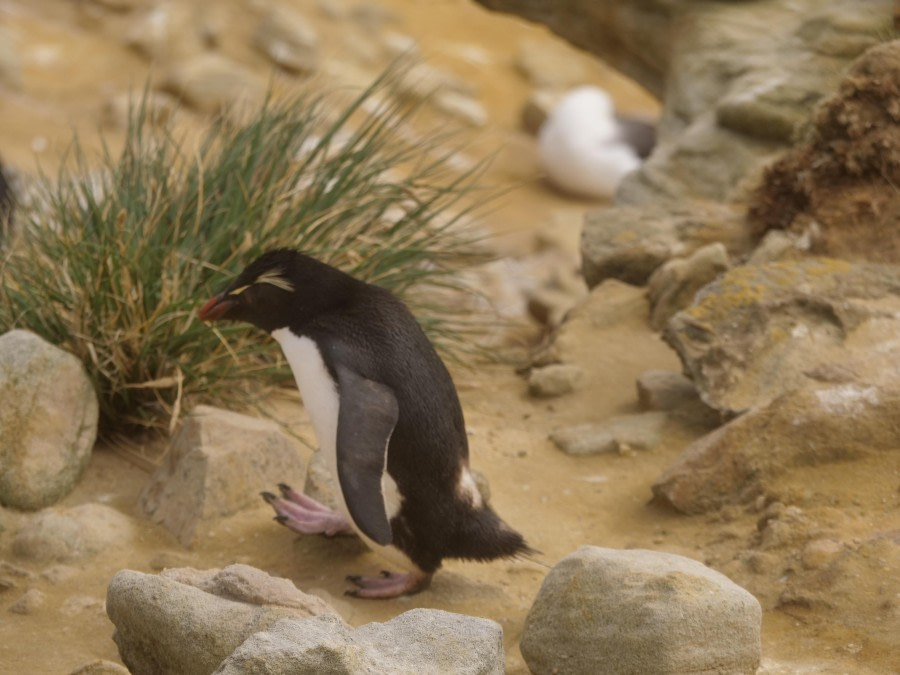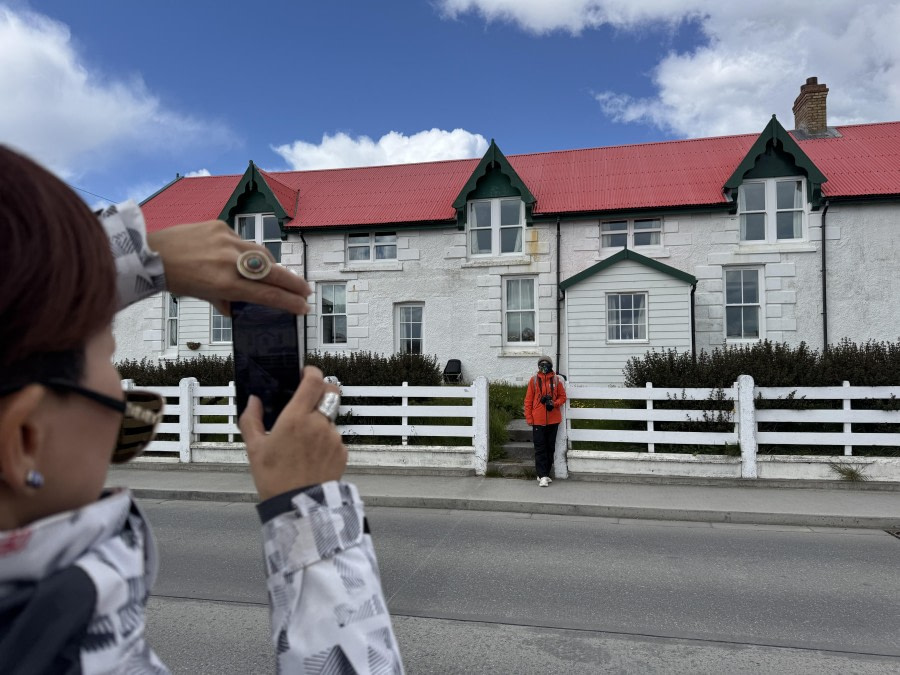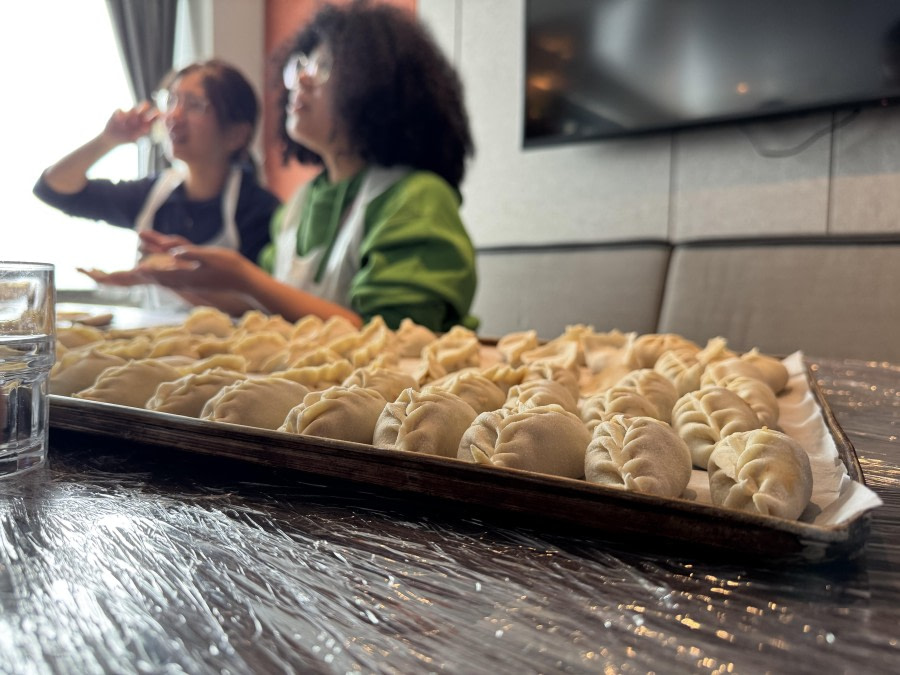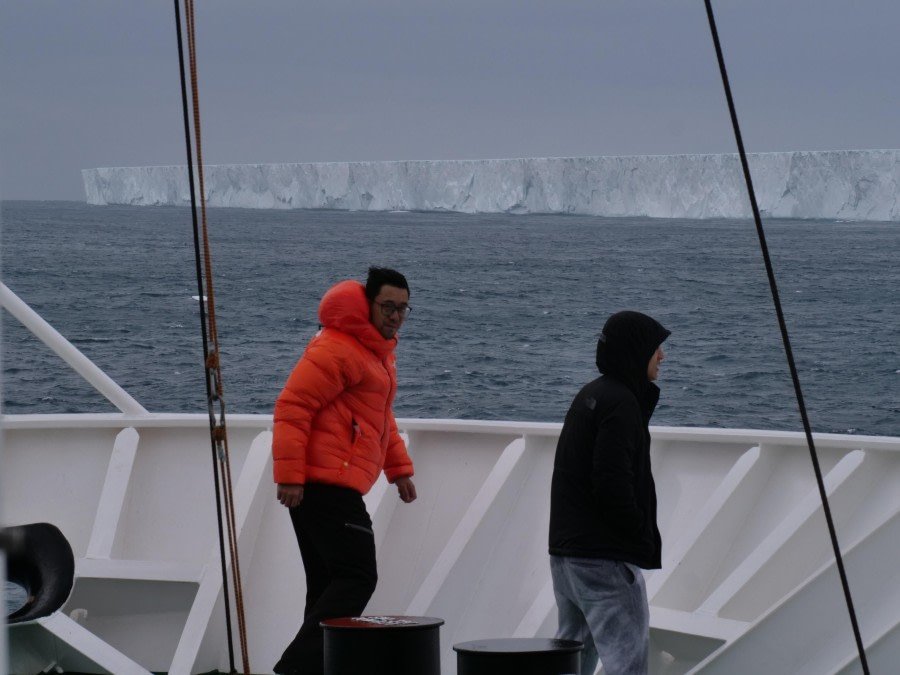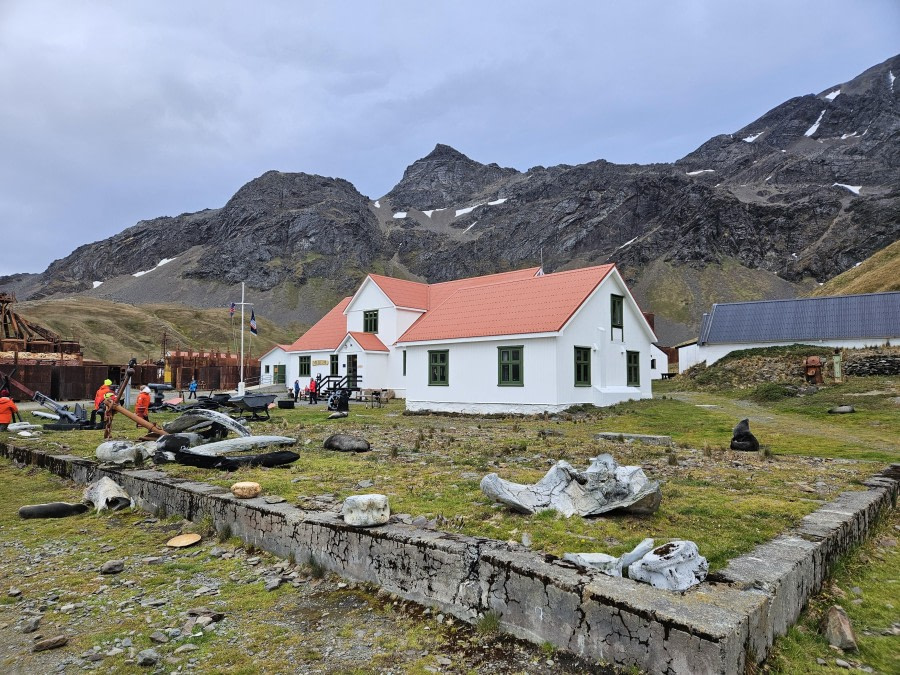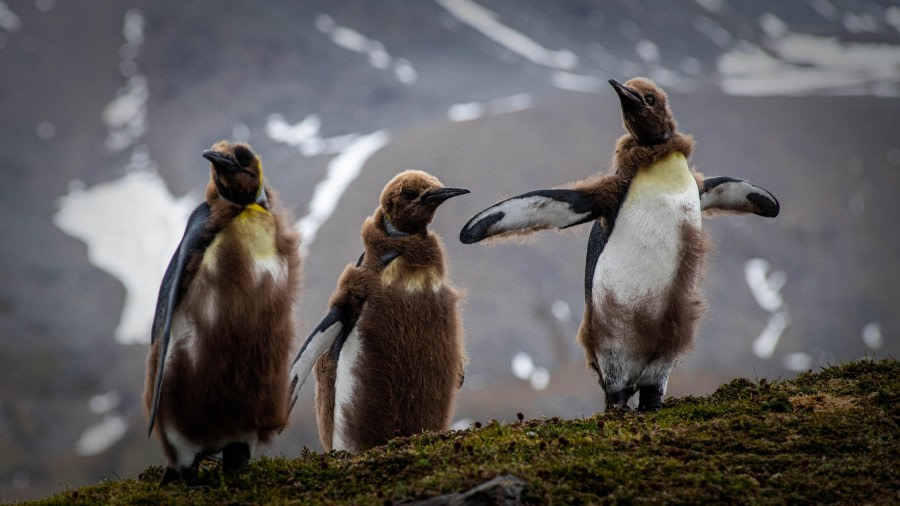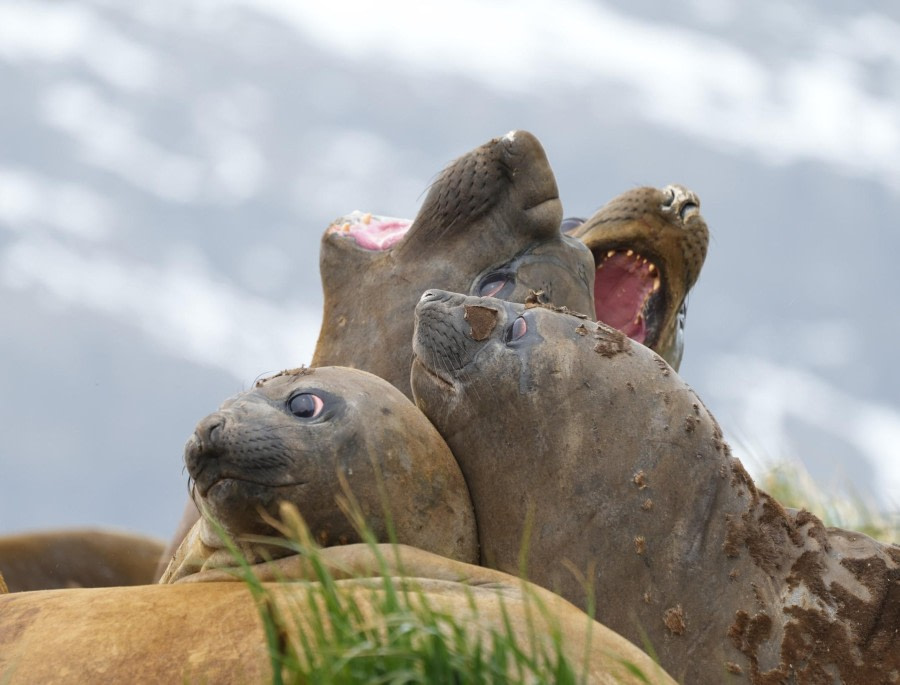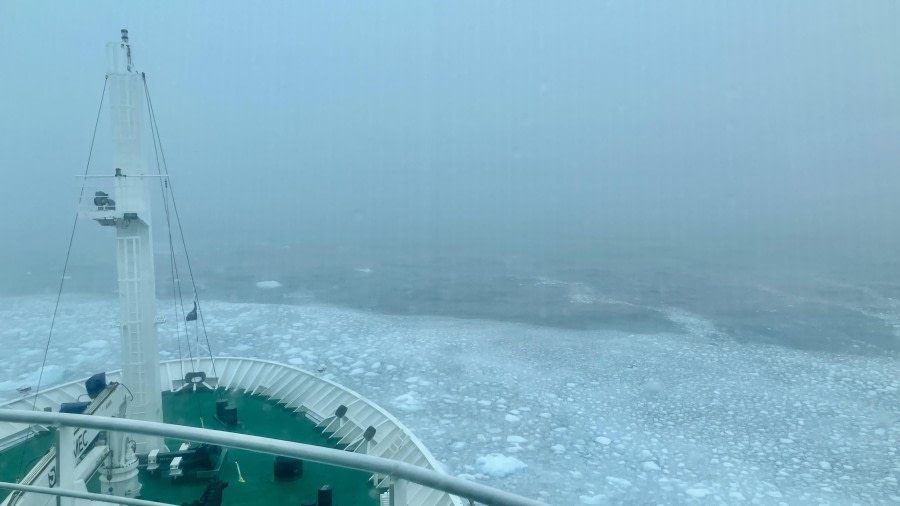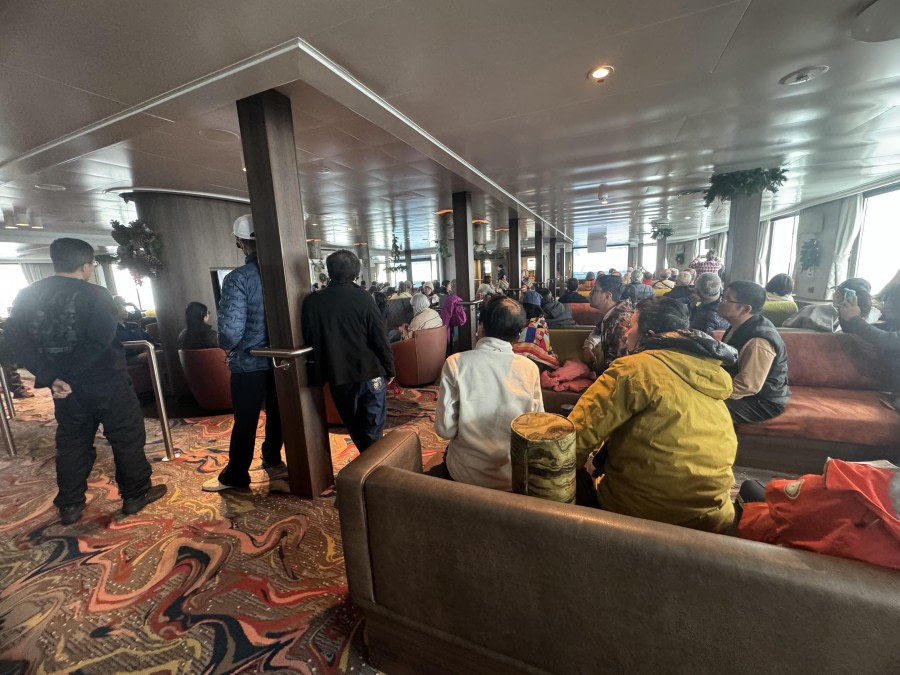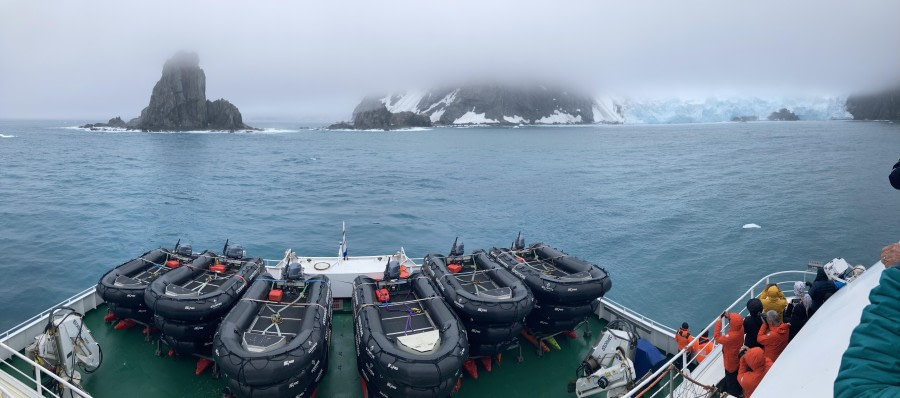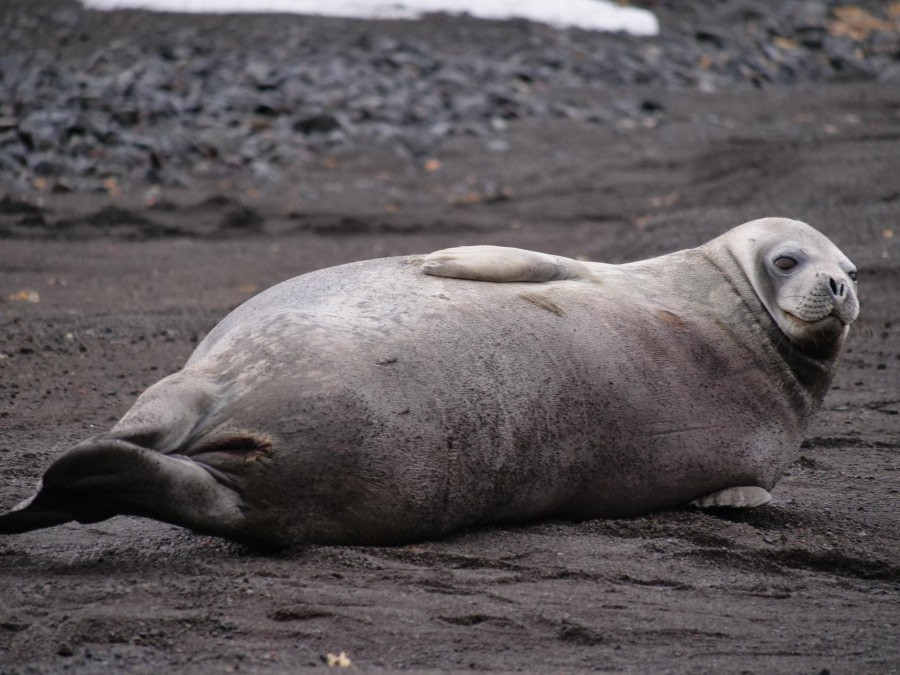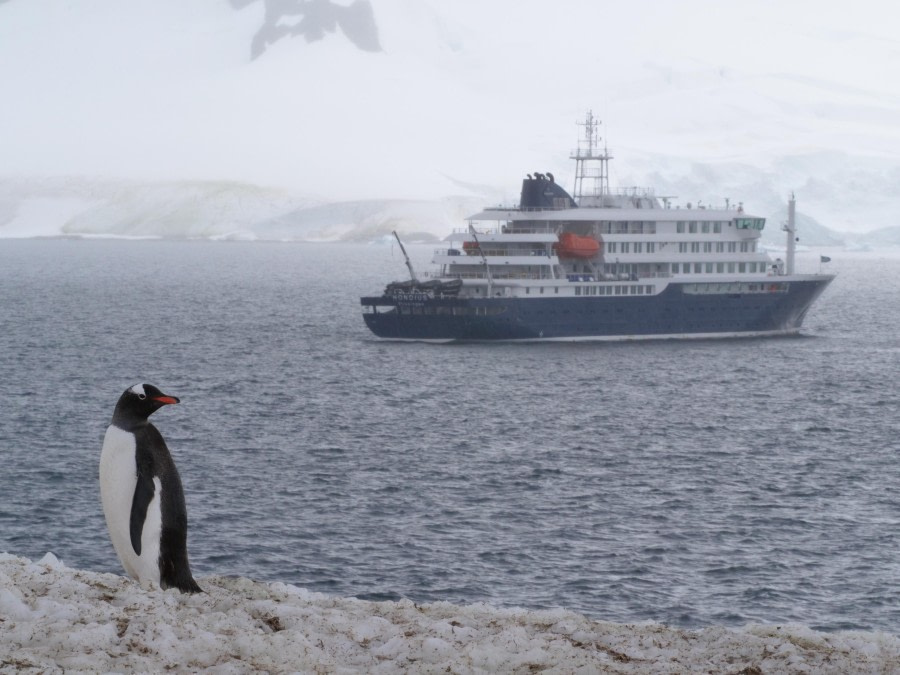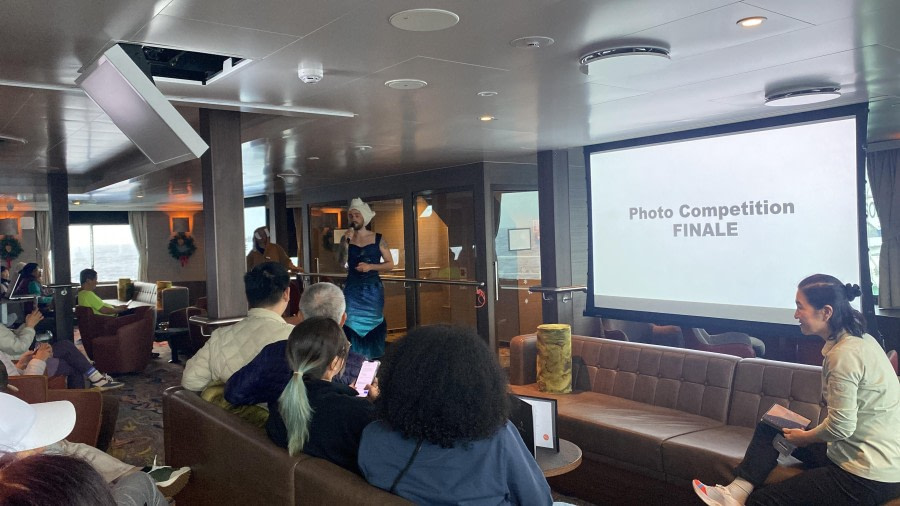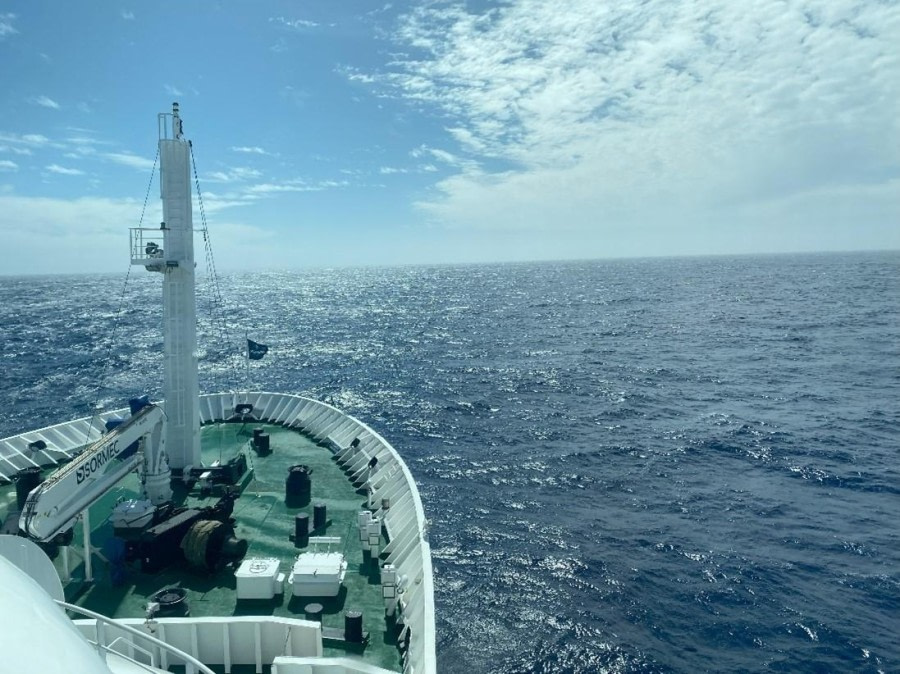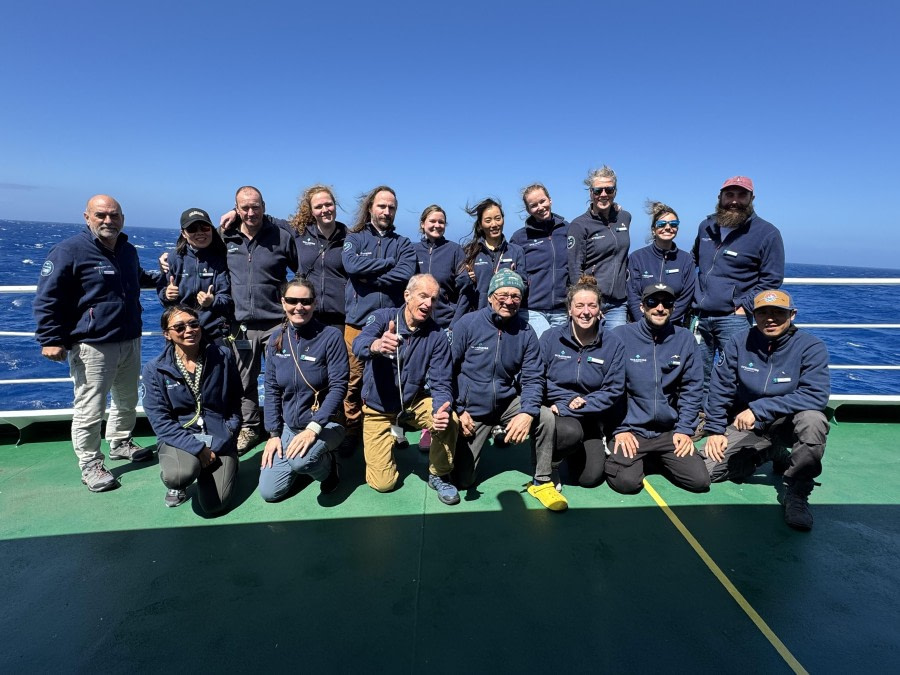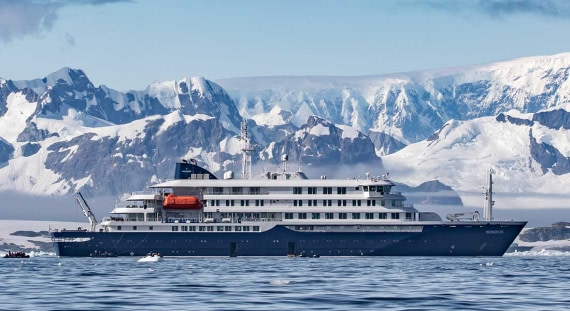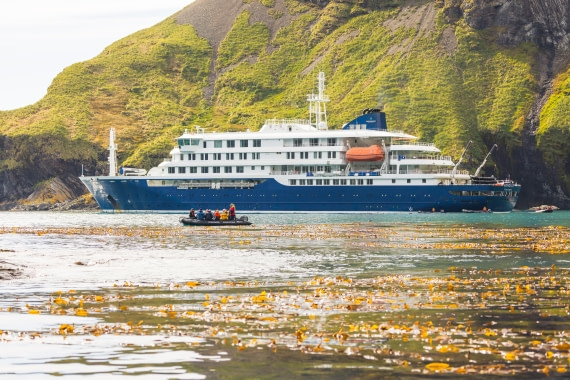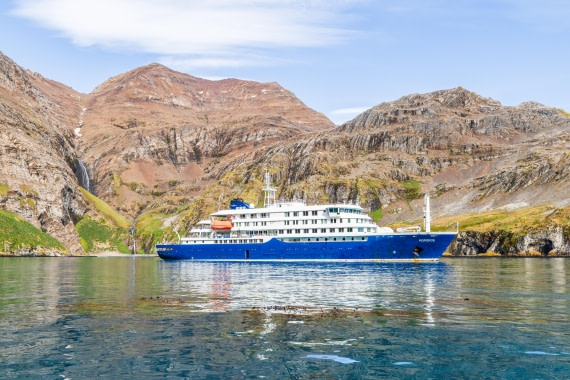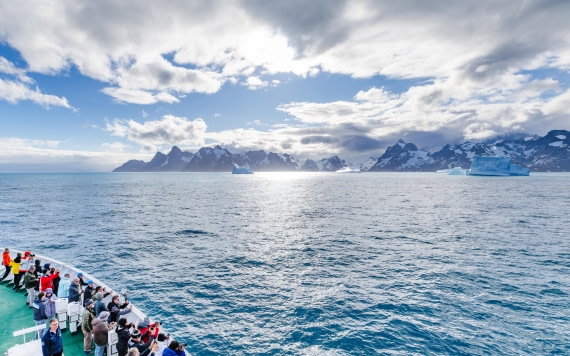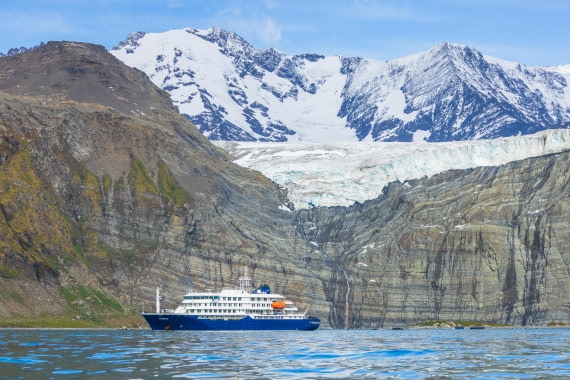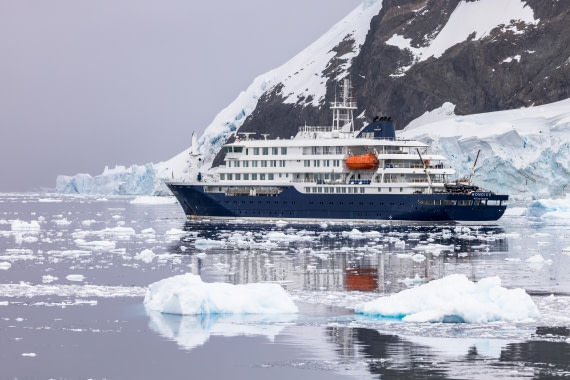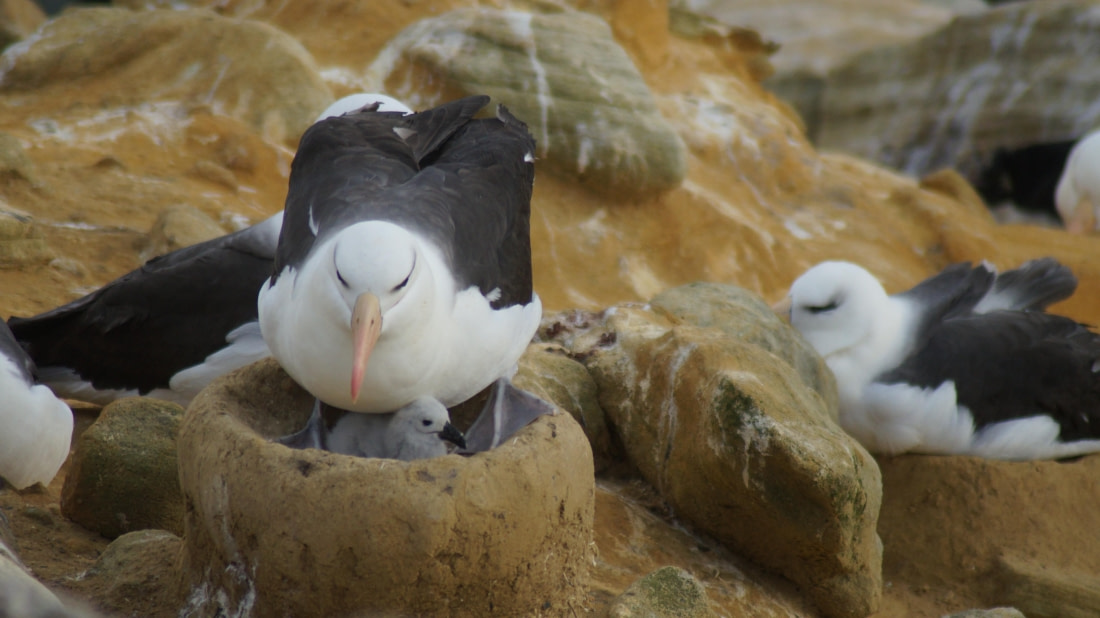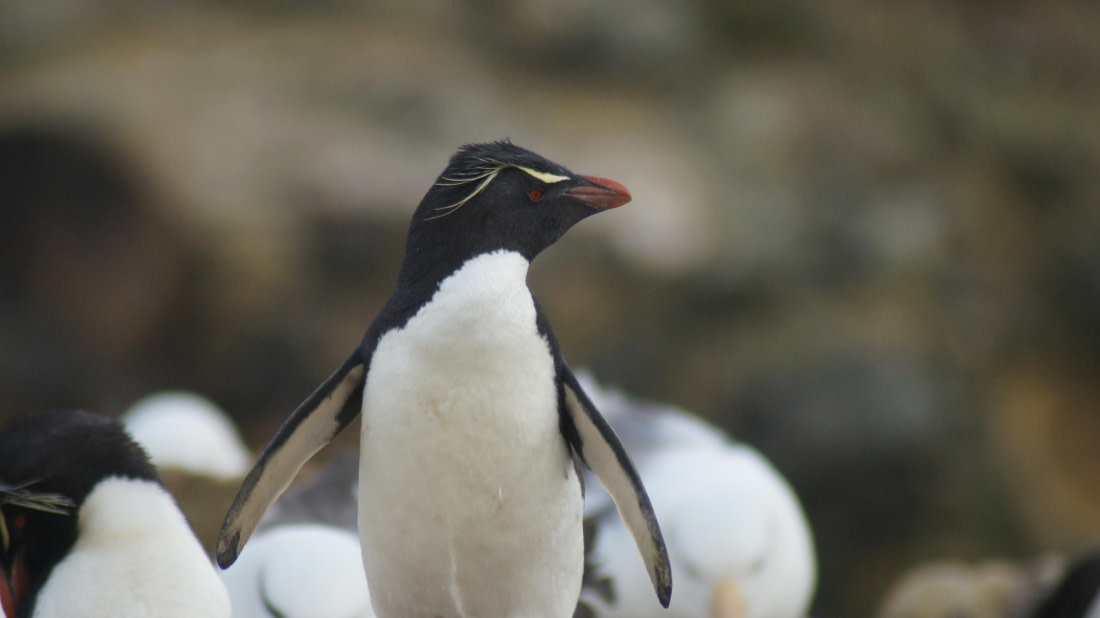| Datum: |
24.12.2024 |
| Positie: |
54°26.1’S, 036°10.3’W |
| Wind: |
Varied 1 |
| Weer: |
Overcast |
| Luchttemperatuur: |
0 |
A profound silence enveloped everything. It was the kind of silence so special, so fragile, that you wouldn't dare break it — so much so that you’d rather stand still, unmoving, no matter how long it lasted. In the pre-dawn gloom, white snowy sheathbills could be made out, flitting above the decks of the Hondius like oversized moths. The sea was calm; the flag at the ship’s bow hung limply, lifeless. The ship itself rocked gently on the slow, low, yet powerful swells of the Southern Ocean. The rhythmic heaving of the waves, a distant echo of a storm that had passed by, seemed to take out its fury on the shoreline, hurling enormous breakers onto the sand. Here and there, meeting a cliff or a rocky outcrop, the waves exploded skyward in plumes of spray.
Despite this, St. Andrew’s Bay appeared remarkably serene. A valley encircled on three sides by towering mountains carried on with its usual life. To the east, the sky was rapidly turning pink, heralding the sunrise. Like embers in a fire that had smoldered all night, the clouds glowed brighter and brighter with each passing moment. Three o’clock in the morning — or rather, a quarter past three. What an ungodly hour. The start of an endlessly long, and equally endlessly fascinating day.
By 3:55 a.m., the entire expedition team had gathered at the shell door on the third deck. As the heavy, reinforced door swung open, a Zodiac was already waiting, and everyone busied themselves loading the gear needed for the shore landing. Pippa, the expedition leader, commandeered a spare Zodiac to scout ahead. Plans, after all, existed to be revised on the fly.
At exactly 4 a.m., George’s voice filled the ship's speakers. That day, he — the first assistant expedition leader — had been tasked with the wake-up call. His warm, resonant tone was ideally suited for the job, pulling everyone from Morpheus’s embrace like a fishing net dragging reluctant catch to the surface. Groggy passengers sitting on their bunks struggled to make sense of the world, only to recall that this day, according to the schedule, had an exceptionally early start. Hastily, they scrambled to get ready and set off in pursuit of adventure.
News soon arrived from the shore: Pippa and a few guides had successfully landed. A positive sign — it meant the landing was feasible! However, the Zodiac cruise had to be canceled; the seas near the shore were too rough. Safety concerns aside, photographers would find such conditions infuriating, as the incessant motion rendered clear shots impossible. Only four Zodiacs remained on the water — enough to ferry everyone ashore and back later.
Meanwhile, the sun climbed higher. It had risen above the horizon, casting its morning light across the world, but the mountains encircling St. Andrew’s Bay to the east continued to shield it from view. Fully dressed and ready, we gathered near the shell door, when at last a brilliant ray of sunlight pierced the jagged dragon’s-teeth peaks, momentarily blinding us. The world instantly transformed — more vivid, more exhilarating. Yet the moment passed quickly; the sun climbed higher, disappearing behind a thick veil of clouds.
Groups of ten at a time boarded the Zodiacs, heading for the shore. The high but steady swells carried us smoothly along, aligning with our direction. The real challenge, however, awaited us at the landing site. Simply pulling up to the beach wasn’t an option; the Zodiac driver had to catch a wave like a surfer and ride it, letting the surf propel the craft onto the sand. Our guides, to their credit, executed this maneuver flawlessly. Once the Zodiac landed, we needed to disembark without hesitation and move several meters inland. Expedition team members directed us from there, explaining where to go, what to observe, and how to avoid trouble with the territorial fur seals. The Zodiac drivers, meanwhile, rode the next wave back out to sea, ready to repeat the process until everyone had landed.
We took in our surroundings. A sandy beach gave way to a grassy valley, bordered by towering mountains, massive glaciers, and a terminal moraine already overgrown with vegetation. The early morning air was crisp, as invigorating as our excitement.
The beach and valley teemed with wildlife: giant petrels dozing with heads tucked under wings, elephant seal pups weaned by their parents, fur seals scanning their surroundings with haughty vigilance, and, of course, countless king penguins. Their main colony lay beyond the glacial moraine. Cameras at the ready, we began to move forward, eager to immerse ourselves in this incredible scene.
The journey ahead was no short stroll — it even included wading through a lively little river that meandered through the valley, originating from a glacial lake. Our route, or more accurately, our trajectory, was marked by red poles planted by our ever-thoughtful guides.
Moving from pole to pole, occasionally negotiating with the disgruntled fur seals objecting to our presence, we eventually reached the riverbank. To our surprise, the banks were claimed by hundreds of molting penguins. They stood motionless along the water’s edge, shedding their old feathers, which drifted away in the current, while sleek, bright new ones emerged in their place. Molting is a grueling process for penguins. During this time, they lose their waterproofing and can’t swim, meaning they fast for weeks, standing dejectedly on the riverbank until the ordeal is over. Careful not to disturb them, we crossed the river with the active assistance of our guides. The water wasn’t deep, but the current was impressively strong.
A few hundred meters farther, we began ascending the moraine. On one of the slopes, right beside the trail, we stumbled upon a skua’s nest. A chick, full of energy, scurried around exploring its surroundings, while the parents watched vigilantly to ensure nothing happened to their offspring. When someone paused to snap a few photos, one of the adults spread its wings menacingly, puffed out its chest, and opened its beak in a display of defiance — a clear signal to move along.
A few more steep steps, another sharp incline, and we reached the summit of the moraine. There, waiting for us, was Mark, our ornithologist, flanked by a couple of guides. Mark’s face bore a lopsided grin, hinting that he was privy to a secret and relishing our forthcoming reaction. The answer to his unspoken riddle revealed itself within moments as we crossed the final few meters. The moraine dropped steeply into the western part of the valley, which spread out before us like a vast tableau. And there — there! Thousands, tens of thousands, no, hundreds of thousands of king penguins. We were standing before the largest colony of these magnificent birds in the world. Transfixed, we stood rooted to the spot, struggling to believe what our eyes beheld. It took a while for us to recover and start noticing the details.
At first glance, the colony was a chaotic riot, underscored by the cacophony of penguin calls — a din so intense we had to raise our voices to converse, though most of us, awestruck, preferred silence. Amid the apparent disorder, certain patterns emerged. “Nurseries” of chicks, absurdly clad in their fluffy brown down, huddled together in groups. The adults were engaged in their routines: some waddled toward the sea, while others lumbered back with stomachs full of krill and fish. Most penguins, however, simply stood still, neither coming nor going.
Alas, our time was limited, and we couldn’t linger for hours on the moraine summit. Before long, we had to retrace our steps, once again skirting hostile fur seals, wading across the river, and weaving between elephant seal pups.
Any seasoned traveler venturing into a remote wilderness knows that the return journey demands as much effort as reaching the destination. Similarly, as we stood on the beach donning life jackets, it was clear that getting back to the ship would require navigating the surf once more in a Zodiac, entrusted to the skill of our guides.
On Pippa’s signal, the driver expertly rode a wave and “beached” the Zodiac. Our task was to climb aboard as quickly as possible — a feat complicated by the waves slamming into the craft’s stern, dousing us in cold, salty seawater mixed with sand and a generous helping of penguin feathers. Brrr.
Reaching the Hondius shell door, we disembarked one by one, braving the pitching of the waves with help from the guides and crew. Back in our cabins, we hung our soaked gear to dry before heading — who would have guessed? — to breakfast. It was astonishing to realize it was only breakfast time; such is the nature of a day that begins at 4 a.m.
After breakfast, a hush fell over the ship. Morpheus, it seemed, had returned to claim his due. Many of us took the chance to nap, though some immediately began editing the photos taken during the landing.
Meanwhile, the weather turned fickle. Low clouds crept stealthily through the mountain passes from the island’s southern coast, shrouding the valley. A light snow began to fall, bringing with it a biting chill. It was a relief to already be aboard.
Before long, the captain ordered the anchor raised, and the Hondius set course for the site of our afternoon activity: Godthul Bay. The name, translating from Norwegian as "good valley," was promising. The journey was lengthy, taking about three hours. During that time, everyone, including the guides, had the opportunity for a well-deserved rest.
Godthul appeared to be very cozy, and this impression was not misleading. The water's surface barely rippled, and the oceanic swell hardly reached us; only in a few places was it slightly difficult to approach the shore. The *Hondius* dropped anchor, and the expedition team began preparing the Zodiacs so we could explore the shores of the bay and its inhabitants in more detail. The weather was overcast, but there was no rain or snow. Unlike our morning experience, getting into the Zodiacs now was much easier, and in less than half an hour, everyone was divided into boats, heading in different directions but all toward the shore.
Like any other bay in South Georgia, Godthul was framed by high mountains, their slopes covered with tussock grass. A narrow strip of beach was densely occupied by local fauna — fur seals, mostly their pups, elephant seals, mostly their pups, and gentoo penguins. However, a couple of king penguins were also present.
We moved slowly along the shore, observing the animals and their behaviors. Those of us who were interested in ornithology mostly focused on kelp gulls, giant petrels, and listened carefully, hoping to spot the endemic species — the South Georgia pipit. These tiny, sparrow-sized songbirds were on the verge of extinction just a few years ago because the rats brought by whalers to the island ruthlessly devoured both the pipits and their eggs. These birds survived only on neighboring islands, but interestingly, once the island eradication program was successfully completed, they returned and began rapidly multiplying, once again reclaiming their homes from the cursed rats. Some of us were lucky enough to observe a pipit fluttering from rock to rock.
After returning to the ship, we gathered in the observation lounge for the daily recap, where Pippa shared plans for the upcoming day, and William, our hotel manager, delighted us with the news that instead of the usual dinner in the restaurant, we would have a Christmas barbecue on the open deck, with mulled wine provided by the establishment.
We dressed warmly and lined up. Our chefs, engineers, and even the officers on the bridge all participated in grilling the meat over the coals. Tables and benches were set up on the deck. It was wonderful — having dinner with a view of the beauties of South Georgia. No restaurant, even one with three Michelin stars, could compare to this. Music played, we conversed, sipping mulled wine, while the ocean lazily and gently rocked our ship. The twilight deepened, and the world around us gradually lost its outlines. Tomorrow — Christmas.
